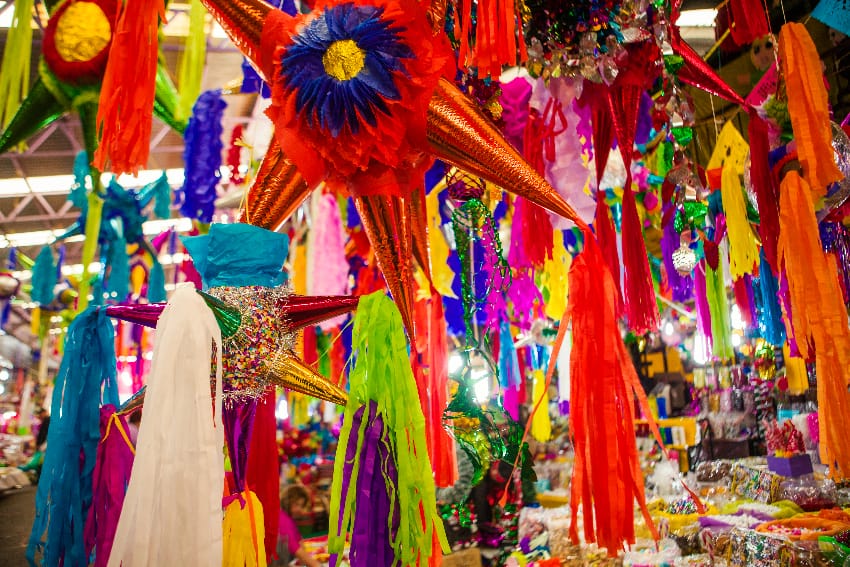Christmas celebrations in many regions of Mexico are still primarily associated with Catholicism. While foreign traditions like Santa Claus or the trending “Elf on the Shelf” have found a place in the heart of many Mexican families, most people in the country still recognize Christmas as a celebration of the birth of Jesus Christ rather than just a time to exchange gifts.
For many Mexicans, then, the true meaning of Christmas lies in the meaning behind Jesus’ birth and what it meant to the world. This meaning is reflected in many Mexican Christmas traditions such as posadas, the nativity scene, pastorelas, and the Reyes Magos (Wise Men), which we will explore below.
Posadas
To kick off the Christmas season in Mexico, Dec. 16 sees the first of the posadas (a word which literally means “inn” or “lodging”). While today it is mostly celebrated as a potluck/house party, a posada is traditionally a religious festivity commemorating the journey of Mary and Joseph from Nazareth to Bethlehem and the birth of Jesus.
During posadas, families and friends sing the song of the posada, known as la letanía. This song tells the story of Mary and Joseph’s search for shelter before the birth of baby Jesus. To sing the carol, the group divides into two in a call-and-response fashion, with one half standing outside with candles, singing a plea for shelter (representing Mary and Joseph). The other half stands inside the house, representing those who gave shelter to the couple.
Although the practice of this tradition has decreased, many families with young children and Catholic schools still host posadas in this way.
The more popular posada, however, is that which serves as an opportunity to meet with friends and enjoy nice food, drinks, music and sweets.
During this season, it is common for adults to attend several posadas. These may include “the office posada,” “the posada with the in-laws,” “the posada with college friends,” “the girls’ posada with BFFs,” or even “your partner’s posada” with your SO’s group of friends. The list goes on and on and can be quite extensive.
Piñatas
The tradition of hanging piñatas is one of the most representative and joyful traditions in Mexico.

Used at every Mexican kid’s birthday party, you might not know that piñatas were first used for posadas, bearing a religious meaning: the traditional piñata’s seven points represent Catholicism’s seven deadly sins.
While modern piñatas featuring popular cartoon characters are most commonly purchased for birthday parties, the traditional seven-point piñatas are still widely used during the posada season – both at parties for kids and for adults. So don’t be surprised if you’re invited to an adult posada and you find yourself swinging at a piñata.
Pastorelas
Another tradition linked to religion is the pastorela, a theatrical performance starring characters such as Jesus, Mary, Joseph, the devil, angels and shepherds.
The story is always the same: a group of shepherds travel to Bethlehem to worship baby Jesus, who is about to be born. On the way, they cross paths with the devil who tries to stop them by tempting them with one of the seven deadly sins. Finally, evil is defeated with the help of an angel.
These plays are mostly performed at school Christmas events and amongst families with young children. Pastorelas were used during the colonization as a way to explain the origin of Christmas to natives.
The nativity scene
The nativity scene is one of Mexico’s most iconic representations of Christmas. Many Mexicans value displaying a nativity scene at home more than a Christmas tree. However, the nativity does not include the baby Jesus until nochebuena, or Christmas Eve, as per Catholic tradition, which marks the birth of Jesus on that night.
Nochebuena is actually more important than Christmas Day in Mexico – on Christmas Eve, families gather around a large meal that includes traditional dishes like bacalao (cod), turkey or romeritos (seepweed), and do a little ceremony before placing the baby Jesus in the manger. This task is usually performed by the children of the family.
In some affluent neighborhoods, you will see magnificent displays of life-size – or larger – nativity scenes on rooftops. Huge nativity scenes funded by the government are also erected in public spaces and buildings.
Christmas, or Dec. 25, is typically a less festive day and is reserved for recalentado, or leftovers.
Who brings the gifts? Santa Claus, the baby Jesus, or the Three Wise Men?
In the past, the Three Wise Men, known as Los Reyes Magos, were responsible for gifting presents to children on Jan. 6, the Day of the Three Wise Men.
This custom was introduced in Latin America by the Spaniards and has continued to be observed in many households across Mexico City and several southern states.
However, the rest of the country has adopted a modern Western approach, and now, Santa Claus is the one who brings the gifts on Dec. 25. In an effort to keep local traditions and the Catholic faith alive, many families say that Santa Claus brings gifts with the help of baby Jesus.
In Mexico, the traditions of Santa Claus and the Three Wise Men are celebrated, meaning that some children receive gifts on December 25 and January 6. For many families, January 6 is seen as an opportunity for parents to purchase items that their children need and disguise them as presents, such as pajamas, socks, books and clothes.
To wrap up, the Reyes Magos
Jan. 6 (almost) marks the end of the holiday season in Mexico, as in the rest of Latin America and Spain.

On this day, Mexican families and friends hold gatherings and enjoy eating the traditional sweet bread named Rosca de Reyes, known in English as Three Kings’ Cake. Placed inside the bread is a baby Jesus figurine – referencing the Biblical passage describing how Mary and Joseph had to hide baby Jesus from King Herod. Whoever finds the figurine is responsible for treating guests to tamales on Feb. 2, Día de la Candelaria – the last of the Winter events and gatherings in Mexico.
Although the tradition is deeply rooted in Mexican culture and strongly associated with Catholicism, the Spaniards only adopted it after the conquest, who inherited the tradition from the Romans. However, it didn’t have a religious meaning for them. In Spain, people do not hide a baby Jesus figurine inside the bread, nor is the tradition connected to the above Nativity passage. Instead, the Spanish hides a dried bean in the bread representing bad luck, and whoever finds it must pay for the rosca.
That the Rosca de Reyes took on a religious meaning in Mexico is a testament to the influence of Catholicism in Mexico’s Christmas traditions, many of which are still alive across the country.
¡Feliz Navidad!
By MND writer Gaby Solís
